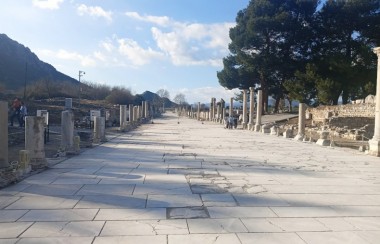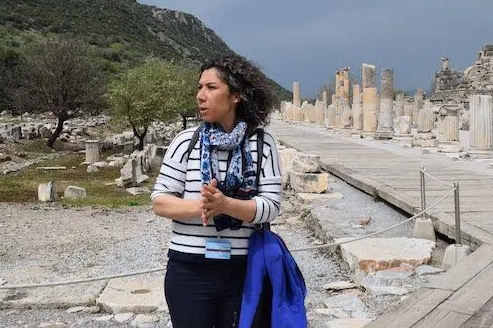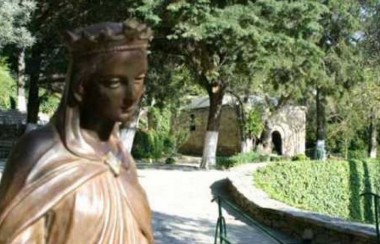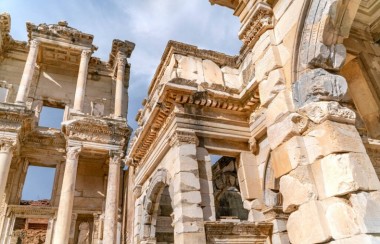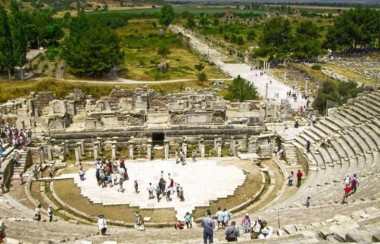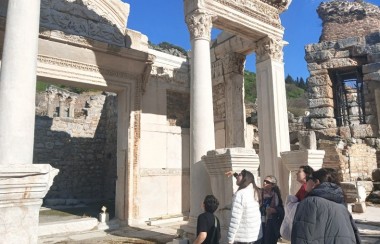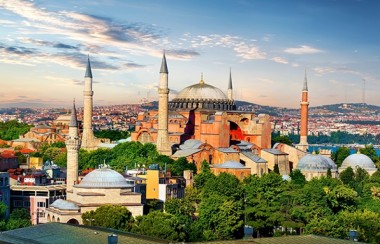Arcadiane Street is a colonnaded road, named after Emperor Arcadius, who reigned between 395 and 408 CE. However, this name is misleading, because there is strong evidence for the existence of this street in the much earlier Hellenistic period, at least from the 1st century BCE. This theory is supported by exposed fragments and foundations of the Harbour Gate, located on the axis of the road at its western end. Arcadius only rebuild the earlier road after a series of earthquakes, raising its level.
Arcadiane Street is well preserved and extends for a distance of more than 500 meters, keeping the width of 11 meters. It starts at the theatre and ends near the ancient harbour. At both ends of the Arcadiane, there were monumental gates in the form of triumphal arches, with three passageways each. However, the gate near to the theatre was destroyed. One can only imagine numerous emperors and ancient celebrities arriving by sea to Ephesus and then walking to the city centre along this ceremonial road.
Arcadiane Street was designed to be the showcase of Ephesus for the newly arrived guests. Interestingly, it was aimed to draw the focus of these visitors to itself and not to the surroundings. The continuous back walls of the side halls completely blocked out the external vistas and isolated the space of the street from the natural environment.
Two walkways for pedestrians, located on both sides of the road, have a width of 5 meters each. In the past, these Corinthian order porticoes were paved entirely with mosaics. Behind these arcades, there were numerous shops, so walkers could make purchases while strolling along the shaded and sheltered sidewalks, at the same time enjoying the breeze blowing from the sea. Sewage channels ran beneath the marble flagstones of the street.
It is also known from the excavated inscriptions that road even had street lighting, as stated by Ammianus: "the brilliancy of the lamps [of Arcadiane] at night often equalled the light of day". An inscription discovered during the excavations of the street confirms this claim as it informs that fifty lamps illuminated the Harbour Street at night. This was a quite rare luxury in the Roman, testifying to the wealth of the city.
In the middle of the road, there were four columns in the Corinthian order, which once held, most probably, the statues of the Four Evangelists. Today, only one of these columns is still standing while of the other three only the bases have been preserved. These bases have the niches displaying Christian symbols. The columns were erected during the reign of Emperor Justinian in the 6th century CE, again as an essential message to the guests of Ephesus that they were entering a Christian city. However, in the Byzantine period, the street was situated outside the city walls and the erection of these four columns in the 6th century marks the zenith of its last golden age.
Related Shore Excursions
Explore Ephesus History with our Shore Excursions .
The Best Of Ephesus And The House Of Virgin Mary
Ephesus played an important role in the spread of Christianity. Ephesus is&...
Ancient City Of Ephesus, House Of Virgin Mary, Basilica Of St. Jhon
Ephesus played an important role in the spread of Christianity. Ephesus is&...
Archaeological Ephesus Tour
Majestic Ephesus takes you on an unforgettable journey through history; etched on minds as the...
Secrets Of Ionia
Miletus which was a great Ionian Port, with two lions guarding its entrance and the theater, reconst...
Roman Heritage & Ottoman Marvels
Blue Mosque, Byzantine Hippodrome, Hagia Sophia, Mevlana Bazaar, Topkapi Palace

